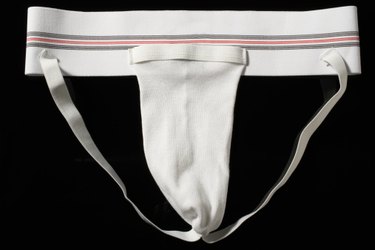
The decision to wear a jock strap when you work out depends on your personal preferences, what you are doing, and what other clothing you're wearing at the time. In any activity where there is a reasonable risk that the most sensitive organs of your body might sustain an injury, it makes good sense to practice caution and protect your equipment. If you aren't sure about whether you really need a jock strap, talk to your coach, a doctor or certified personal trainer.
Definition
Video of the Day

The jock strap was born in 1874. At that time, male bicyclists were bouncing along Boston's cobblestone streets, and a company called the Bike Web Company stepped forward to support them. For 130 years, Bike has continued to be the world's largest supplier of jock straps.
Video of the Day
The standard jock strap consists of a supportive front panel held in place by an elastic waist band and two elastic straps that go around the sides of buttocks, leaving your backside open to the air. Some jock straps have a pouch in front to hold a hard plastic cup, which can prevent serious injury in contact sports.
Function
The purpose of the jock strap is to hold the male genitals in place and suppress excessive motion. That's not to say you can't get the same support any other way: a supportive pair of briefs may serve the same antibouncing purpose. The biggest benefit of the jock strap is the ability to add the protective cup.
Sports
According to the University of Michigan Health System, football, soccer, gymnastics, basketball, hockey, baseball and track carry a high risk of injury. Athletic supporters are recommended for all these sports. If you are playing a sport in which the odds are good that something will hit you in the groin, wearing a protective cup can save you from intense pain and serious injury. You could actually lose a testicle due to a sports injury.
Disadvantages
Once upon a time, all guys wore jock straps and no one felt weird about the rear-end ventilation. Times have changed, and the jock strap is not as ubiquitous as it once was. You may not like the idea of having your bum exposed when changing clothes at the gym. The bulky front might chafe your skin, and some people find the design generally uncomfortable.
Alternatives
There are choices when it comes to athletic support. In addition to containing the genitals, compression shorts support the whole upper leg and seat, holding everything in place and out of harm's way. A study published in the "Journal of Sports Science" in 2003 indicated that compression shorts might increase performance and help prevent injury to the upper leg muscles.
If you play a contact sport and need the protection of a cup, there is a wide range of gear that blend the benefits of traditional underwear, compression shorts and jock straps into one package. All the different designs have their own pros and cons, so try different types and see what works for you in your sport.